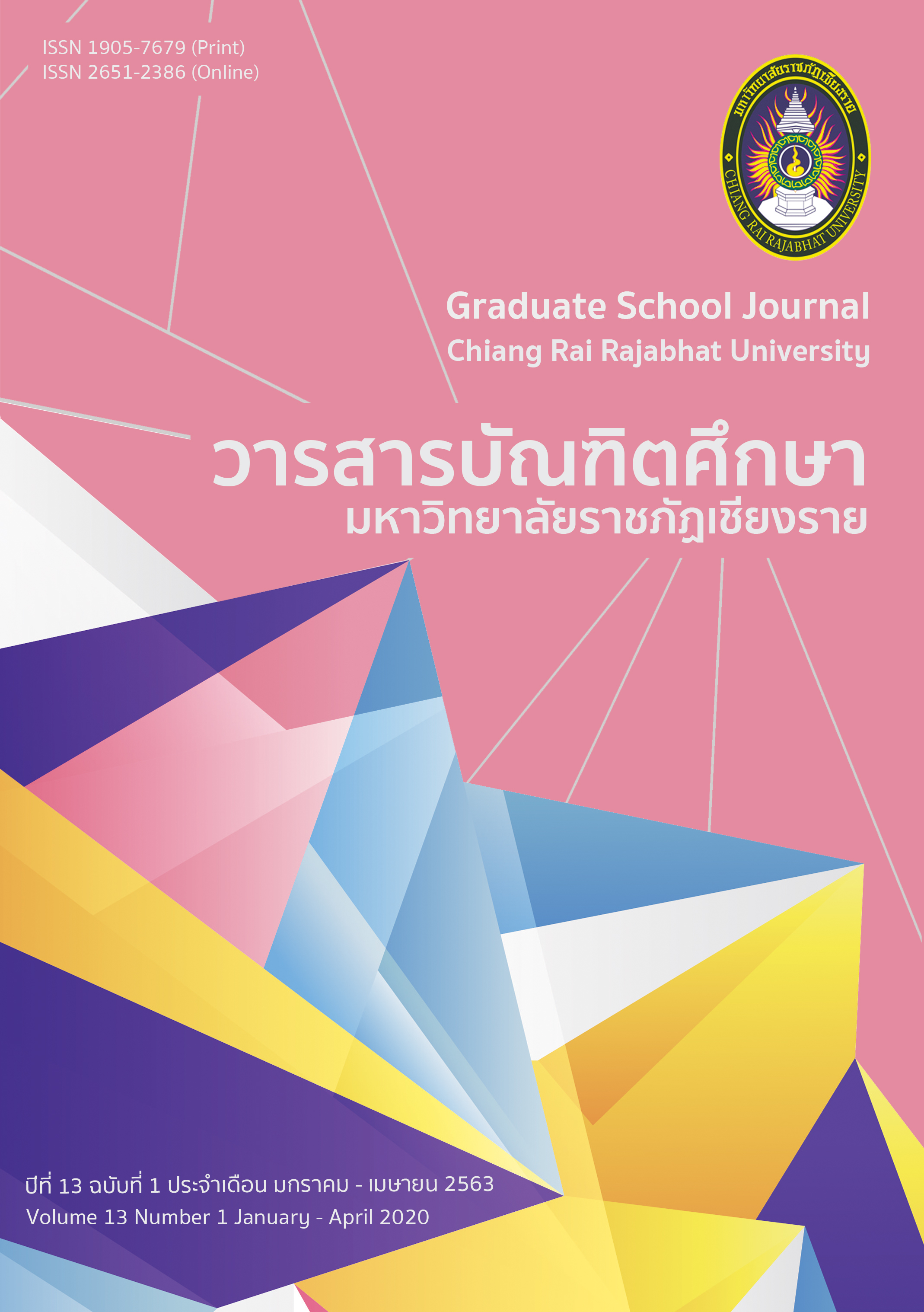ปัจจัยเชิงสาเหตุการจัดการเรียนรู้ที่ส่งผลต่อทักษะการเรียนรู้ในศตวรรษที่ 21 ของนักเรียนโรงเรียนเครือข่ายสะเต็มศึกษาภาคเหนือ
Main Article Content
บทคัดย่อ
การวิจัยครั้งนี้มีวัตถุประสงค์เพื่อศึกษาปัจจัยการจัดการเรียนรู้ และทักษะการเรียนรู้ในศตวรรษที่ 21 เพื่อตรวจสอบความสอดคล้องของปัจจัยเชิงสาเหตุของโมเดลที่สร้างขึ้นกับข้อมูลเชิงประจักษ์ และเพื่อศึกษาอิทธิพลรวม ทางตรง และทางอ้อม ปัจจัยเชิงสาเหตุการจัดการเรียนรู้ที่ส่งผลต่อทักษะ การเรียนรู้ในศตวรรษที่ 21 ของนักเรียนโรงเรียนเครือข่ายสะเต็มศึกษาภาคเหนือ กลุ่มตัวอย่างที่ใช้ในการวิจัยครั้งนี้ ได้แก่ นักเรียนชั้นมัธยมศึกษาปีที่ 3 โรงเรียนเครือข่ายสะเต็มศึกษาภาคเหนือ ภาคเรียนที่ 1 ปีการศึกษา 2560 จำนวน 380 คน ซึ่งได้มาจากวิธีการสุ่มแบบชั้นภูมิ (Stratified Random Sampling) เครื่องมือที่ใช้ในการเก็บรวบรวมข้อมูลเป็นแบบสอบถามปัจจัยเชิงสาเหตุการจัดการเรียนรู้ที่ส่งผลต่อทักษะการเรียนรู้ในศตวรรษที่ 21 ประกอบด้วยปัจจัยพฤติกรรมการสอนของครู การอบรมเลี้ยงดูของผู้ปกครอง บรรยากาศในชั้นเรียน เจตคติต่อการเรียน และแรงจูงใจใฝ่สัมฤทธิ์ วิเคราะห์ข้อมูลโดยการหาค่าเฉลี่ย ส่วนเบี่ยงเบนมาตรฐาน และการวิเคราะห์เส้นทาง (Path Analysis) ผลการวิจัยพบว่า
1. ปัจจัยที่มีค่าเฉลี่ยสูงสุด คือ เจตคติต่อการเรียน มีค่าเฉลี่ยเท่ากับ 4.26 (S.D. = 0.52) ปัจจัยที่มีค่าเฉลี่ยน้อยที่สุด คือ พฤติกรรมการสอนของครู มีค่าเฉลี่ยเท่ากับ 4.10 (S.D. = 0.54)
2. โมเดลที่พัฒนาขึ้นมีความสอดคล้องกับข้อมูลเชิงประจักษ์โดยพิจารณาจากค่า c2 = 67.33, p= 0.72, GFI = 0.98, AGFI = 0.95, RMR = 0.014, RMSEA = 0.00, Standardize Residual = 1.97 รวมทั้งกราฟคิวพล็อต (Q-Plot) มีความชันกว่าเส้นทแยงมุม ซึ่งโมเดลสามารถอธิบายความแปรปรวนของปัจจัยทักษะการเรียนรู้ในศตวรรษที่ 21 ได้ร้อยละ 83
3. ปัจจัยที่มีอิทธิพลรวมที่ส่งผลต่อทักษะการเรียนรู้ในศตวรรษที่ 21 สูงสุด คือ ปัจจัยด้านบรรยากาศในชั้นเรียน (TE = 0.63) ปัจจัยที่มีอิทธิพลทางตรง (DE) สูงสุด คือ ปัจจัยด้านบรรยากาศในชั้นเรียน และเจตคติต่อการเรียน (DE = 0.34) ปัจจัยที่มีอิทธิพลทางอ้อมสูงสุด คือ ปัจจัยด้านบรรยากาศในชั้นเรียน (IE = 0.29) อย่างมีนัยสำคัญทางสถิติที่ระดับ .05
Article Details
บทความที่ได้รับการตีพิมพ์เป็นลิขสิทธิ์ของวารสารมหาวิทยาลัยราชภัฎเชียงราย
ข้อความที่ปรากฏในบทความแต่ละเรื่องในวารสารวิชาการเล่มนี้เป็นความคิดเห็นส่วนตัวของผู้เขียนแต่ละท่านไม่เกี่ยวข้องกับมหาวิทยาลัยราชภัฎเชียงราย และคณาจารย์ท่านอื่นๆในมหาวิทยาลัยฯ แต่อย่างใด ความรับผิดชอบองค์ประกอบทั้งหมดของบทความแต่ละเรื่องเป็นของผู้เขียนแต่ละท่าน หากมีความผิดพลาดใดๆ ผู้เขียนแต่ละท่านจะรับผิดชอบบทความของตนเองแต่ผู้เดียว
เอกสารอ้างอิง
กระทรวงศึกษาธิการ. (2557). การเรียนรู้ในศตวรรษที่ 21. สืบค้นเมื่อ 20 พฤศจิกายน 2558, จาก https://www.moe.go.th/moe/th/news/detail.php?NewsID=38880&Key=news_research
ดวงรัตน์ บุญวัน. (2552). ปัจจัยที่มีอิทธิพลต่อความคิดสร้างสรรค์ของนักเรียนชั้นประถมศึกษาปีที่ 6 สังกัดสำนักงานเขตพื้นที่การศึกษาสุพรรณบุรี. (วิทยานิพนธ์ครุศาสตรมหาบัณฑิต). มหาวิทยาลัยราชภัฏกาญจนบุรี. กาญจนบุรี.
ธัญพร รักแร่. (2554). รูปแบบความสัมพันธ์เชิงสาเหตุแบบพหุระดับของตัวแปรที่มีอิทธิพลต่อความคิดสร้างสรรค์ทางคณิตศาสตร์ของนักเรียนชั้นมัธยมศึกษาปีที่ 4. (วิทยานิพนธ์การศึกษามหาบัณฑิต). มหาวิทยาลัยมหาสารคาม. มหาสารคาม.
นงลักษณ์ วิรัชชัย. (2542). โมเดลลิสเรล สถิติวิเคราะห์สำหรับการวิจัย. กรุงเทพฯ: จุฬาลงกรณ์มหาวิทยาลัย.
เบ็ญจพร ภิรมย์. (2552). ปัจจัยเชิงสาเหตุที่ส่งผลต่อความสามารถการคิดวิเคราะห์ของนักเรียนช่วงชั้นที่ 3 สังกัดสำนักงานเขตพื้นที่การศึกษาศรีสะเกษ เขต 1. (วิทยานิพนธ์การศึกษามหาบัณฑิต). มหาวิทยาลัยมหาสารคาม. มหาสารคาม.
ภูริณัฐ กระแสโสม. (2550). รูปแบบความสัมพันธ์เชิงสาเหตุที่ส่งผลต่อการคิดอย่างมีวิจารณญาณของนักเรียนชั้นประถมศึกษาปีที่ 4 ในสำนักงานเขตพื้นที่การศึกษาศรีสะเกษ เขต 1. (วิทยานิพนธ์การศึกษามหาบัณฑิต). มหาวิทยาลัยมหาสารคาม. มหาสารคาม.
มรุต ก้องวิริยะไพศาล. (2549). การวิเคราะห์ความสัมพันธ์ของปัจจัยเชิงสาเหตุที่มีอิทธิพลต่อความพร้อมในการเรียนรู้ด้วยตนเองของนักศึกษาชั้นปีที่ 1 มหาวิทยาลัยราชภัฏสวนดุสิต. (วิทยานิพนธ์ปริญญาศึกษาศาสตรมหาบัณฑิต). มหาวิทยาลัยศรีนครินทรวิโรฒ. กรุงเทพฯ.
วิจารณ์ พานิช. (2555). วิถีสร้างการเรียนรู้เพื่อศิษย์ในศตวรรษที่ 21. กรุงเทพฯ: ตถาตา พับลิเคชั่น.
สังวรณ์ งัดกระโทก. (2553). เอกสารประกอบการอบรมหลักสูตรการใช้โปรแกรมลิสเรล. นนทบุรี: มหาวิทยาลัยสุโขทัยธรรมาธิราช.
สิรินภา กิจเกื้อกูล. (2558). สะเต็มศึกษา. วารสารศึกษาศาสตร์ มหาวิทยาลัยนเรศวร, 17(2), 201–207.
สุภาพร แดนสมปัดสา. (2555). โมเดลสมการโครงสร้างพหุระดับปัจจัยที่มีอิทธิพลต่อการคิดวิเคราะห์ของนักเรียนชั้นมัธยมศึกษาปีที่ 4. (วิทยานิพนธ์การศึกษามหาบัณฑิต). มหาวิทยาลัยมหาสารคาม. มหาสารคาม.
อภิญญา แฝดกลาง. (2557). ปัจจัยที่มีอิทธิพลต่อการคิดวิเคราะห์ของนักเรียนชั้นประถมศึกษาปีที่ 6 สำนักงานเขตพื้นที่การศึกษาประถมศึกษานครราชสีมา เขต 5. (วิทยานิพนธ์การศึกษามหาบัณฑิต). มหาวิทยาลัยมหาสารคาม. มหาสารคาม.
Good, C. V. (1973). Dictionary of education. (3rd ed). New York: McGraw-Hill.


